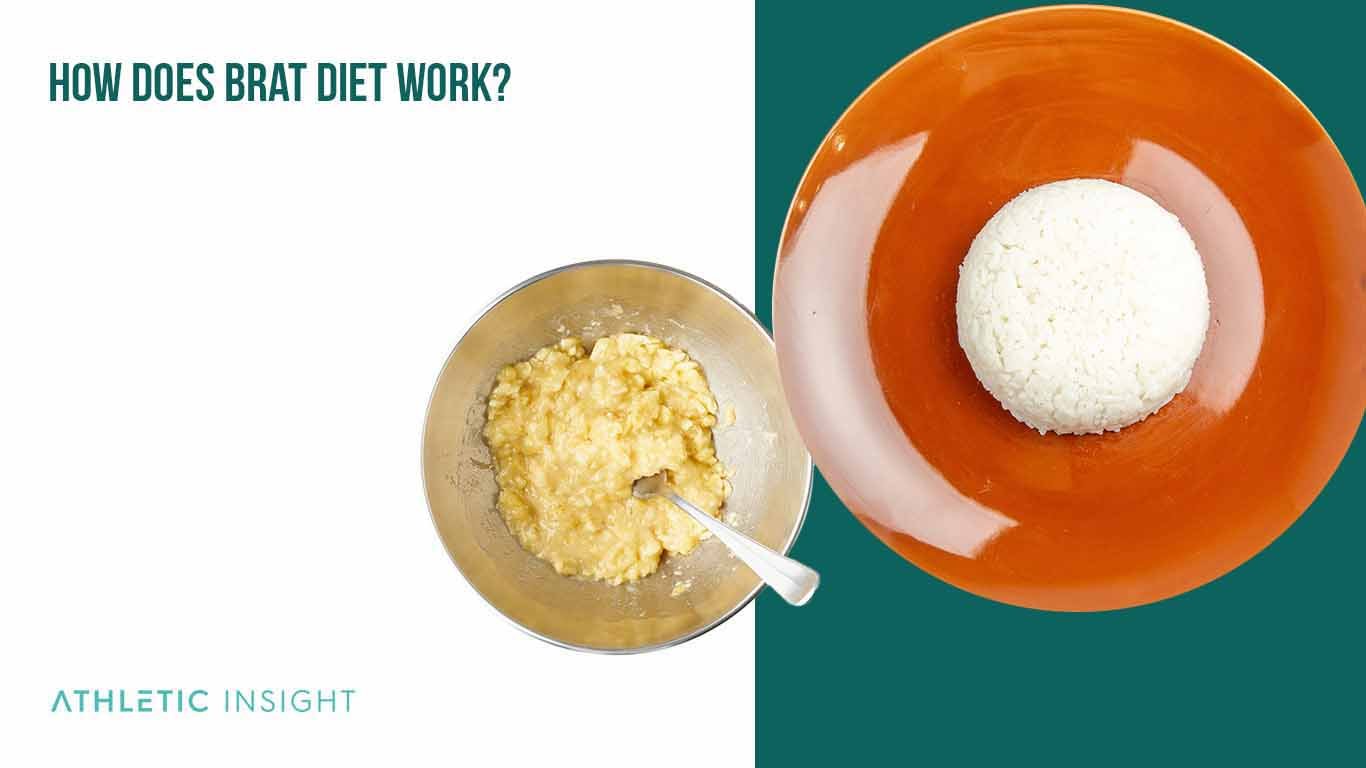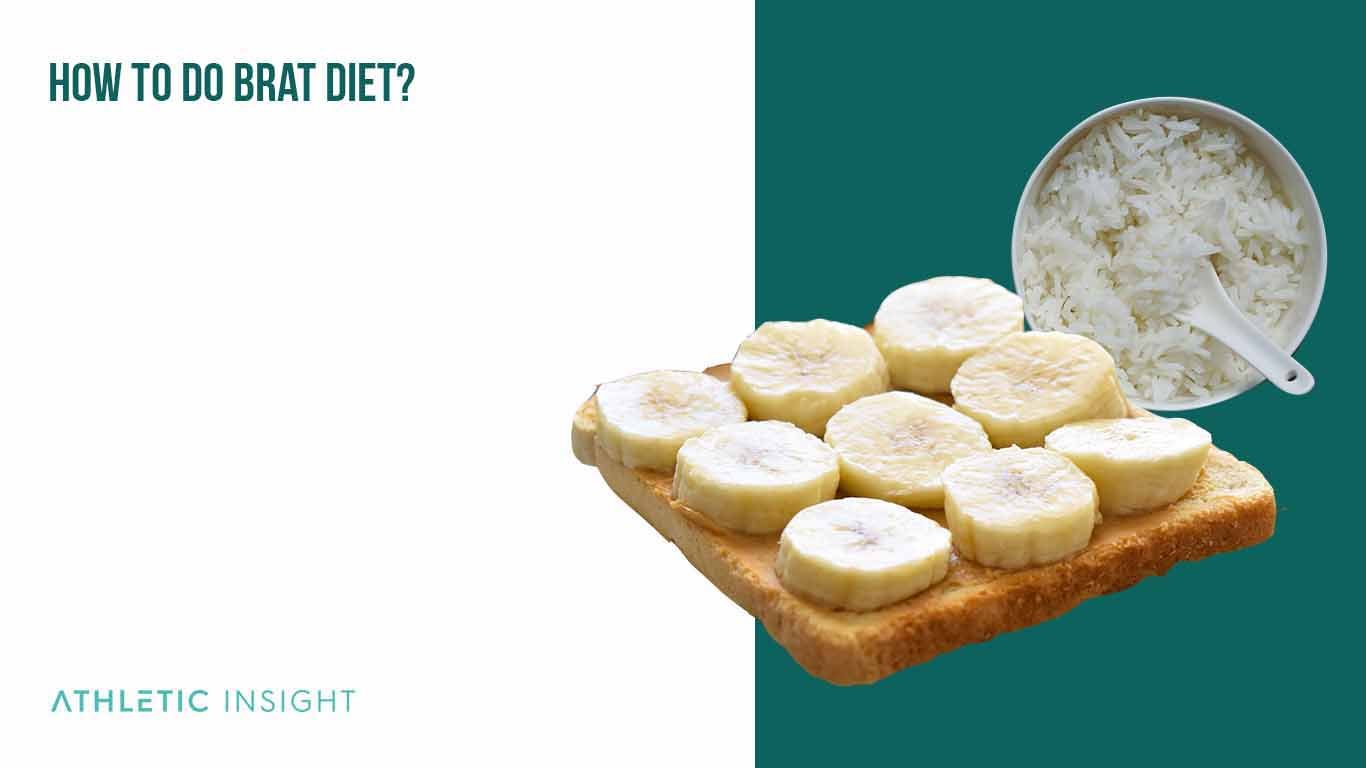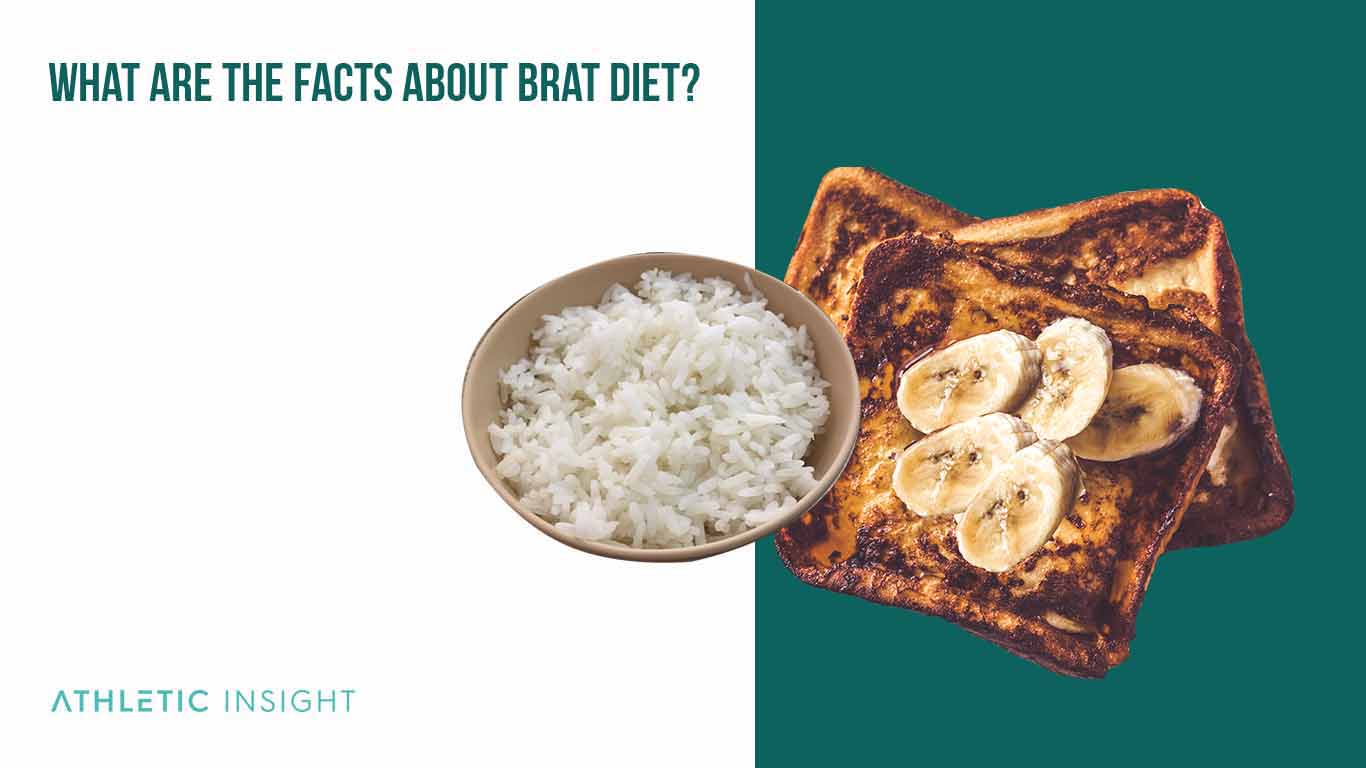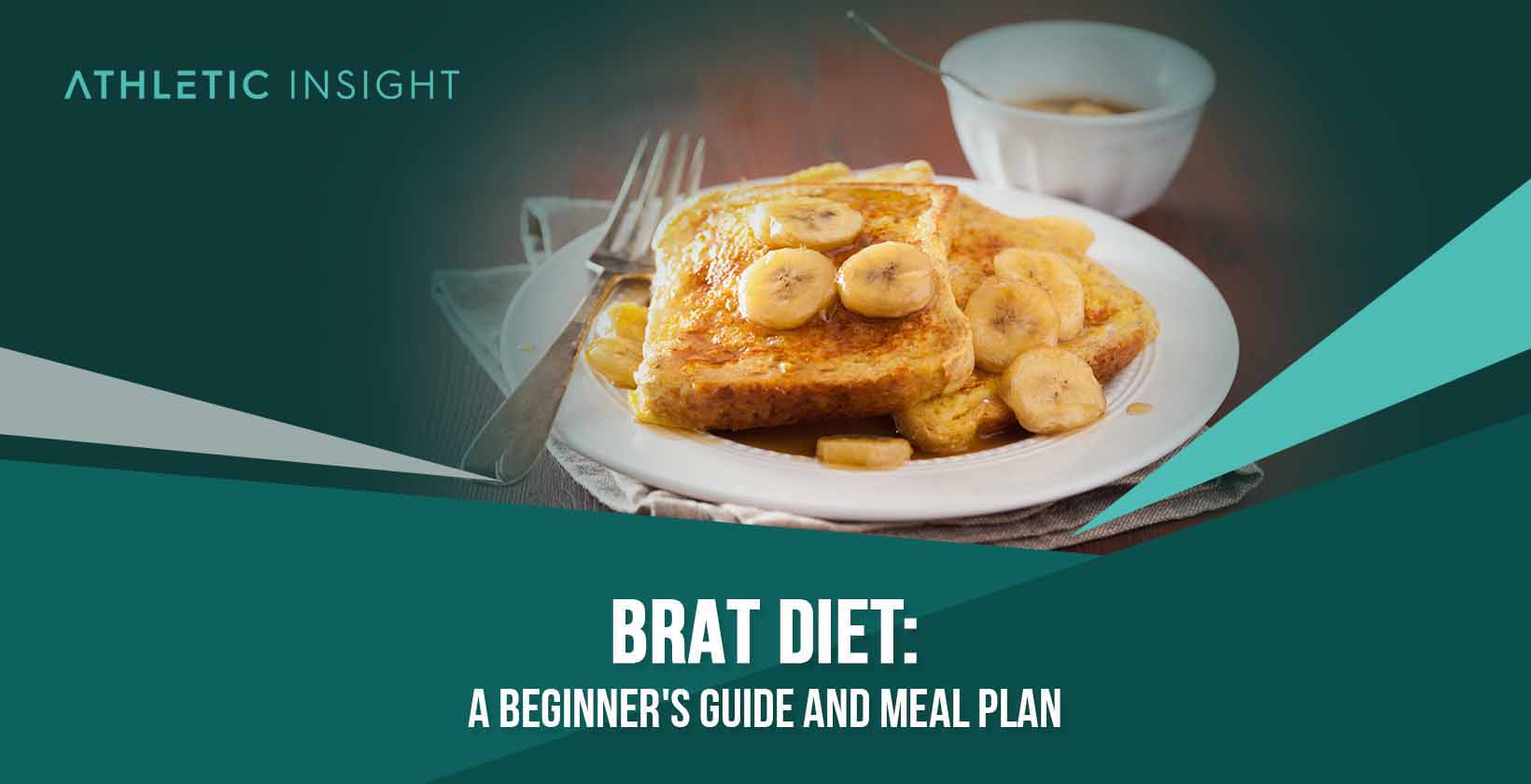The brat diet is a diet typically recommended for children with diarrhea, vomiting, or other digestive issues. Its name is an acronym representing the four main foods included in this diet: bananas, rice, applesauce, and toast. Each of these foods is a binding food that helps to solidify stools and settle the stomach.
While its initial purpose was to soothe children and infants with digestive issues, adults can benefit from the brat diet as well. They can supplement the brat diet with other simple, starchy foods such as saltine crackers, boiled potatoes, and oatmeal.
Since it is so restrictive, the brat diet does not work as a long-term diet plan. Its primary purpose is to solve ailments in the digestive system.
How Does the Brat Diet Work?
To do the brat diet, you will need to restrict your diet to bland, low-fat, and low-fiber foods. These mainly include bananas, rice, applesauce, and toast, which is where the acronym comes from. A few other foods and beverages are compatible with this diet as well.

There are two main ways the brat diet treats stomach issues. One reason is that it includes several binding foods, which help the body produce firm stools. Another way the brat diet works is by eliminating high-fat foods that trigger nausea, heartburn, vomiting, and diarrhea.
Initially, the body may react to brat diet options as it does to other foods, especially if the trauma to the digestive system is extensive. In time, however, these mild binding foods will help settle the stomach and stop digestive ailments.
If you want to use a brat diet for adults, you should be sure to stick to these simple foods only. While you normally may be able to digest stronger foods than a child, the brat diet will only work if you do not supplement it with other foods high in fat, sugar, or other ingredients.
How To Do the Brat Diet As An Adult
While the brat diet first started as a remedy for children, the brat diet for adults can still be effective. Doing the brat diet as an adult is not much different from how a child would do it. Simply eliminate all foods from your daily routine that are not compatible with the brat diet.
If you do it correctly, the brat diet can ease symptoms within a few days. If you do not see any changes after doing the brat diet for adults, stop the diet and consult your doctor for further advice.
What Are the Health Benefits of the Brat Diet?
There are a few significant benefits to the brat diet for adults and children. Aside from using the brat diet for diarrhea, nausea, and vomiting, there are an additional few reasons the brat diet might be helpful for you.
- Good for Heart Health: high-fiber foods reduce blood pressure, inflammation, and cholesterol.
- Reduces Cancer Risk: the brat diet lacks foods with heavy levels of processing, hydrogenated oils, and other ingredients that increase the risk of cancer.
- Prevents Type 2 Diabetes: the low amount of complex sugars in the brat diet helps prevent complications in those at risk of Type 2 Diabetes.
- Lowers Blood Pressure: high-fiber foods reduce blood pressure and keep arteries clear.
- Decreases Asthma Symptoms: the brat diet is free of many allergens, which can cause asthma symptoms.
- Promotes Bone Health: the brat diet does not have high levels of sodium, which can promote bone health by retaining calcium in the bones.
If you are seeking any of these health benefits, the brat diet may be a suitable option for you. However, if you are planning on using the brat diet for weight loss, you should consult with a physician. Because of the lack of crucial vitamins and nutrients in the brat diet, it is not a good diet to eat for an extended amount of time.
What Are the Health Risks of the Brat Diet?
Some of the health risks of the brat diet include an increased risk of stroke, cholinergic crisis, and hair loss. One of the biggest risks of the brat diet is that it can lead to malnourishment. It is also very low in calories, which can result in unintentional weight loss.
In some instances, the brat diet can worsen symptoms of stomach illnesses. This risk is particularly high if you struggle with chronic issues such as Celiac Disease or food allergies, as many brat diet foods contain gluten.
If you are considering trying the brat diet as an adult, you should keep these risk factors in mind. These risks are not incredibly common, however, especially if you only try the brat diet for a couple of days.
How To Do the Brat Diet
If you would like to try the brat diet, you will need to follow this step-by-step process.
- Eliminate all foods in your diet that are not part of the brat foods list.
- Stock up on items from the brat diet list such as bananas, rice, applesauce, and bread.
- Monitor your symptoms as you stick to this diet. If you notice improvement, you can gradually transition back to your usual eating habits.

You should not stick to the brat diet for any longer than three days. If you are not showing signs of improvement after several days of the brat diet, it might not be the right choice for you. Consider questions such as:
- How many calories are you consuming while on the brat diet?
- What is the proposed time frame for the brat diet?
- What are the best practices for following the brat diet?
Knowing the answers to these questions can help you follow the brat diet safely and get the best results.
When To Consider the Brat Diet
If you are struggling with stomach-related illnesses, it may be time to consider the brat diet. This diet is especially helpful for people who are struggling to keep food down, as the foods included in the brat diet menu are unlikely to trigger vomiting.
People who have loose stools should consider the brat diet as well. When you go on the brat diet for diarrhea, your bowel movements can become more solid.
What are the Foods You Can Eat on the Brat Diet?
The key foods to eat on the brat diet for adults are bananas, rice, applesauce, and toast. These foods are bland, relatively low in fiber, and will not irritate your digestive system.
The brat diet consists of many binding foods, which can help your body produce firm bowel movements. This is why the brat diet for diarrhea is effective for many people.
Even if you cannot restrict yourself to bananas, rice, applesauce, and toast, you may still be able to do the brat diet. Some other foods you can consume while on the brat diet include:
- Fruits: bananas, applesauce, melon, pumpkin, avocado, and canned fruit (packed in water)
- Vegetables: carrots, potatoes, squash, green beans
- Grains: whole grain bread, rice, saltine crackers, plain noodles, cream of wheat
- Legumes: lentils, plain beans
- Nuts: almonds, walnuts
- Seeds: sunflower seeds
- Healthy Fats: yogurt, kefir,
- Proteins: baked turkey or chicken, scrambled eggs, tofu
The easiest way to remember safe foods for the brat diet menu is to follow the acronym: bananas, rice, applesauce, and toast. Here are a few specific foods that are especially beneficial to the brat diet.
1. Crackers
Crackers are bland and can soothe the stomach when you are ill. They are a binding food, which can also help treat diarrhea. Crackers can help fight nausea as well, making them a fitting addition to the brat diet.
Crackers are on the brat diet food list because they are high in starch, which absorbs acid in your stomach. Excess stomach acid can cause issues such as heartburn, diarrhea, and nausea. By absorbing these acids, consuming crackers can ease discomfort.
2. Cooked Cereals
Like crackers, cooked cereals are bland and high in starch, which is helpful for an upset stomach. Examples of cooked cereals for the brat diet include cream of wheat and cream of rice.
Cooked cereals are on the brat diet food list because they are low in fat and fiber. Too much fat and fiber can worsen nausea and diarrhea, making cooked cereals a great alternative.
Reducing fiber in the diet can help with digestive issues, which means low-fiber cooked cereals are compatible with the brat diet.
3. Weak Tea
Tea comes in several flavors, and all of them are suitable for the brat diet. However, tea for the brat diet should not include any caffeine, added sugar, or milk because they can irritate the stomach. You should also brew it lightly, as strong flavors can worsen nausea.
Tea can hydrate you and provide antioxidants. Many people find warm tea soothing to their stomachs when they are feeling sick as well. Tea can be effective in treating diarrhea and nausea, meaning it is a suitable part of the brat diet.
4. Apple Juice
Apple juice is high in vitamin C and contains a small amount of fiber. The best apple juice for the brat diet should be low in sugar.
Apple juice is an anti-inflammatory drink, which means it can help soothe irritation in your digestive system. Overall, diluted apple juice can help treat children with digestive illnesses.
5. Soda
Soda is a carbonated drink that comes in many flavors. While it lacks nutritional value and is often high in sugar, it can still be beneficial for an upset stomach.
Soda’s main ingredient is water, which is essential for people experiencing nausea and vomiting. The carbonated water may also help soothe discomfort in the digestive system. For the best results, you should drink sugar-free, caffeine-free soda while on the brat diet.
6. Broth
Clear broths such as chicken broth and vegetable broth are suitable hot beverages for people who are feeling ill.
Broth is very high in sodium. Because many people lose sodium when they struggle with vomiting or diarrhea, broth can be a suitable way to replenish this essential nutrient.
Chicken broth is a safe way to replenish electrolytes for mild dehydration, earning it a place on the brat diet food list.
7. Boiled or Baked Potatoes
Baked and boiled potatoes are starchy and easy to prepare. They are low in fat and have a bland flavor. Be sure to peel potatoes before eating them on the brat diet, as the skins are more difficult to digest.
Potatoes are low in fiber and high in many essential nutrients like vitamin C and iron. Consuming them while on the brat diet can be a good way to prevent malnourishment.
The potassium in potatoes is important for people dealing with vomiting and diarrhea. Because potatoes are high in potassium, they are a suitable addition to the brat diet.
What Are the Foods You Should Avoid While On a Brat Diet?
Avoiding certain foods is important to ensure that the brat diet is effective. If you consume any non-brat foods while on this diet, your symptoms may worsen.
Here are some foods you should avoid while on the brat diet.
- Meat: pork, veal, and beef
- Poultry: duck and goose
- Fish and Shellfish: salmon, sardines, and most shellfish
- Meat-Based Ingredients: gravy, sausage, ham, and deli meats
- Eggs: other than scrambled eggs
- Dairy Products: cheese, cream, and milk
These foods are more complex than the brat diet requires and may upset your stomach. Once your symptoms improve, you can gradually re-introduce these foods after you have finished the brat diet.
Who Should Do a Brat Diet?
In the instance that you are struggling with nausea or diarrhea, you may want to give the brat diet a try. People suffering from non-chronic stomach illnesses are the ones that should try this diet.
The brat diet is not an effective diet for weight loss or any health issues unrelated to the digestive system. If you are not dealing with nausea, vomiting, or diarrhea, you should not attempt the brat diet. Though bodybuilders and other athletes may use the brat diet for a few days for specific results, it is not meant to be a long-term brat bodybuilding diet.
What Are the Best Recipes for the Brat Diet?
While it is quite restrictive, there are a few ways you can add variety to brat diet meals.
Below are some easy recipes for the brat diet you can enjoy. So if you are starting to get sick of eating the same foods repeatedly, consider trying one of these brat diet-friendly recipes.
- Banana Bread: This simple baked good is delicious and easy on the stomach
- Homemade Applesauce: If store-bought applesauce has too many
- Peanut Butter Banana Toast: With two of the staple brat diet ingredients and added protein from the peanut butter, this is a filling and delicious brat recipe
- Banana Oatmeal: Oatmeal’s simple grains and banana’s high fiber and potassium make this an ideal brat breakfast
- Chicken-Flavored Rice: If you miss a hearty meal, rice flavored with chicken broth is a good alternative
- Low-Fat Mashed Potatoes: The starch and potassium in plain mashed potatoes make this a simple meal to eat while on the brat diet
Combining bland, low-fiber, and low-fat foods is the key to creating unique recipes for the brat diet.
What Is a Sample Brat Diet Plan?
If you have never tried the brat diet before, you may feel unsure of how to plan your meals. However, a brat diet plan is easy to follow.
Day 1
- Breakfast: White bread toast with butter, ginger tea
- Lunch: Saltine crackers, warm chicken broth, apple juice
- Snacks: Applesauce, bananas
- Dinner: Steamed white rice cooked in chicken broth, water
Day 2
- Breakfast: White bread toast with butter, chamomile tea
- Lunch: Saltine crackers, warm vegetable broth, apple juice
- Snacks: Applesauce, sugar-free gelatin
- Dinner: Baked potato with salt and pepper, sugar-free caffeine-free soda
Day 3
- Breakfast: White bread toast with mashed bananas on top, peppermint tea
- Lunch: Cream of wheat, toast with butter, apple juice
- Snacks: Mashed bananas, sugar-free gelatin
- Dinner: Boiled potatoes with salt and pepper, warm chicken broth, sugar-free, caffeine-free soda
Day 4
- Breakfast: White bread toast with butter, applesauce, peppermint tea
- Lunch: White rice cooked in chicken broth, apple juice
- Snacks: Bananas, saltine crackers
- Dinner: Mashed potatoes, warm chicken broth, sugar-free caffeine-free soda
Day 5
- Breakfast: Cream of rice with peanut butter and bananas, apple juice
- Lunch: Baked potato with salt and pepper, warm chicken broth, water
- Snacks: Saltine crackers, applesauce
- Dinner: Cooked noodles with butter, salt, and pepper, sugar-free, caffeine-free soda
Day 6
- Breakfast: Toast with peanut butter and bananas, applesauce, chamomile tea
- Lunch: Cream of wheat with bananas, toast with butter, water
- Snacks: Gelatin, saltine crackers
- Dinner: Mashed potatoes with butter, brown rice, green beans, sugar-free, caffeine-free soda
Day 7
- Breakfast: White bread toast with peanut butter and bananas, applesauce, peppermint tea
- Lunch: Cooked pasta with butter, salt, and pepper, apple juice
- Snacks: Applesauce, soft canned fruit
- Dinner: Baked potato with salt, pepper, and butter, green beans, sugar-free, caffeine-free soda
What Are the Facts About the Brat Diet?
It is important to have a thorough understanding of the brat diet before starting it. Here are a few key facts about the brat diet for adults and children.

What Happens the First Week of the Brat Diet?
During the first week of the brat diet, you should see your stomach symptoms alleviate and begin to feel better. Once you are no longer nauseous, having diarrhea, or vomiting, you should be able to return to your normal diet. If you are still experiencing symptoms, contact a doctor. Similar to the soft food diet, the Brat diet can cause some of the symptoms you are already facing, which may take a day or two before they go away.
How Much Does the Brat Diet Cost Per Month?
The brat diet is full of staple foods such as rice, similarly to the rice diet, and bread. However, it also features fresh foods like fruit and other produce. If you have many of these foods in your home, it might not cost you much. Otherwise, it could cost between $16-$60 per month to remain on the brat diet.
How Does the Brat Diet Compare to the Atkins Diet?
The Atkins diet is a low-carbohydrate diet to promote weight loss and heart health. Like the brat diet, it features many simple, natural foods that don’t have a lot of processed ingredients or sugars. However, unlike the brat diet, it focuses on protein and fats, which are products you should be careful of eating when on the brat diet.
Is the Brat Diet for Weight Loss?
In the long term, the brat diet can lead to malnourishment, so you should not use the brat diet for weight loss. It is also high in carbohydrates and low in protein, both of which can be detrimental to weight loss.
Is the Brat Diet Gluten Free?
While the brat diet cannot treat celiac disease, it can potentially treat symptoms after exposure to gluten. Excluding gluten on the brat diet is very easy, as most foods in this diet do not include this ingredient.
Some components of this diet, such as toast or crackers, do typically contain gluten. However, there are some gluten-free versions of these foods that you can purchase.
The brat diet is naturally low in saturated fat and cholesterol, which makes it a safe and effective diet for many stomach illnesses and other health conditions.
Is the Brat Diet Considered a Healthy Diet?
No, the brat diet is not necessarily a healthy diet. It is low in several essential nutrients that people need for their health. Getting enough protein, fats, vitamins, and fiber is difficult for people who are on the brat diet.
One good thing about the brat diet is that it is low in saturated fats and cholesterol. However, there are more efficient ways to reduce your fat and cholesterol intake.
In the short term, the brat diet is safe for adults and children. Overall, however, it does not constitute a healthy diet.
Is the Brat Diet Expensive?
No, the brat diet is not expensive. Most of the foods you consume with this diet are staples that you likely already have in your home.
Foods such as oatmeal, rice, bread, applesauce, and crackers are usually affordable, long-lasting foods. Even fresh produce like bananas are among the cheapest fruits at most grocery stores. So even if you have to go shopping for brat diet-friendly foods, you will not need to spend a whole lot of money.
What Is the Relevance Between Brat Diet & Diarrhea?
The relevance between the brat diet and diarrhea is that this restrictive diet can help treat loose bowel movements. The brat diet helps with diarrhea because it mostly consists of binding foods. Examples of binding foods are cooked cereal, applesauce, and unflavored crackers. These foods are low in fiber and can make stools firmer.
Another way the brat diet helps with diarrhea is that it eliminates foods that frequently cause this condition. Greasy foods, spicy foods, and dairy products, which are not part of the brat diet, are common diarrhea triggers for many people.
The brat diet can also help ease nausea and stomach cramping, which are common symptoms that occur alongside diarrhea. Overall, a bananas, toast, applesauce, and rice diet for diarrhea can be a suitable option for both children and adults.



